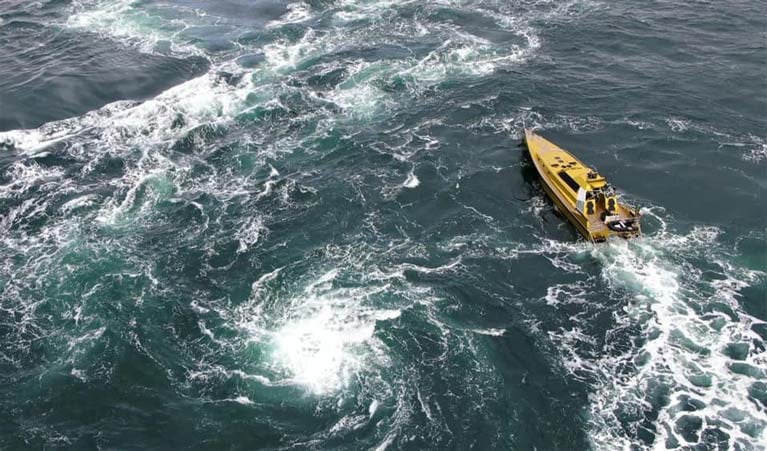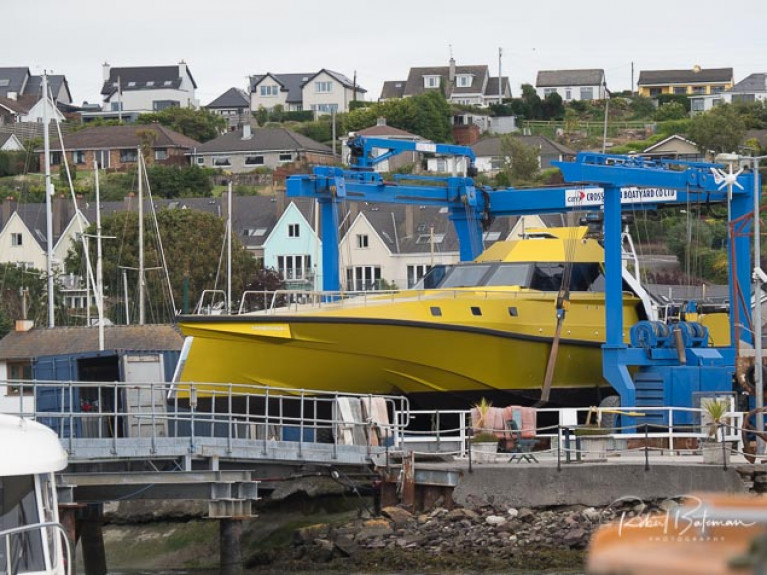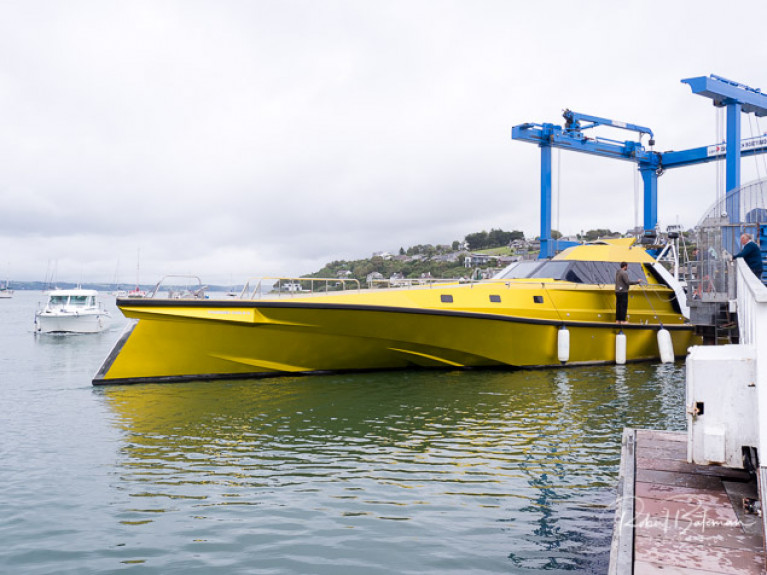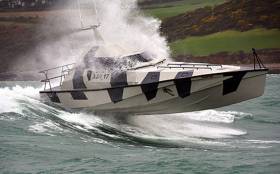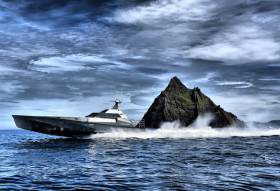Displaying items by tag: Thunderchild
Record Breaking Powerboat 'Thunder Child II' Tours North of Ireland Ports & Coastline
It’s not often a record-breaker visits Bangor but Safehaven Marine’s Managing Director Frank Kowalski, who set the Round Ireland and Rockall Record in the original 17 metre XSV 17 demonstrator Thunder Child in 2017, brought his striking yellow hulled Thunder Child 11 for an overnight in Bangor on Belfast Lough before heading north to Ardfern on Loch Craignish on the Scottish west coast.
It is understood that the idea was to sample the Gulf of Corryvreckan, the narrow strait between the islands of Jura and Scarba, off the west coast of mainland Scotland, famous for its strong tidal currents and standing waves. The whirlpool which forms at the right state of the tide is the third largest in the world.
The Round Ireland record was set in 2017 at 34 hours, 01 minute and 47 seconds as reported here
 Thunderchild II along side at Bangor Marina on Belfast Lough
Thunderchild II along side at Bangor Marina on Belfast Lough
After the visit to the Scottish west coast, the vessel returned to Bangor to refuel, then headed to Belfast where it spent the night before going south with another stop in the County Down fishing port of Kilkeel.
Thunder Child 11 was designed and built in Youghal in Co Cork by Safehaven Marine and as reported in the Irish Examiner, Managing director Frank Kowalski describes the super-swift craft as “a unique, hybrid hull design, asymmetrical catamaran, with a wave-piercing deep V mono-hull”. It is 23 m in length, has a 5.3 m beam and boasts a Hyuscraft hydrofoil system fitted between the two catamaran hulls. It is valued at over €1m.
The fastest crossing of the Atlantic is the ultimate goal but this attempt has been postponed due to the Covid 19 outbreak and travel restrictions. Safehaven Marine said that “ Due to the very small Greenland sea ice and North Atlantic weather window that existed for us to make the attempt, it is not going to be possible for us to undertake the voyage this.
Safehaven Marine's Frank Kowalski has announced that his planned Trans-Atlantic record attempt this year in Thunder Child II has been postponed.
Speculation mounted this week when the asymmetrical catamaran was lifted out of the water in Cork Harbour that it might be the start of record bid preparations.
Kowalski told Afloat 'Regretfully Safehaven Marine have had to postpone our planned Trans-Atlantic record attempt this year in Thunder Child II. This is due to the COVID 19 crisis and the global logistical and travel restrictions in place'.
It had previously been indicated that between July and August 2020 the same five-member crew that set a record time Round Ireland also aboard Thunder Child II, would attempt an unprecedented 4,500 km transatlantic route from Killybegs to Newfoundland via refuelling stops at Greenland and Iceland.
Kowalski also told Afloat via social media: "Due to the very small Greenland sea ice and North Atlantic weather window that existed for us to make the attempt, sadly it is not going to be possible for us to undertake the voyage this year".
The fully refurbished Thunderchild II was on the hoist at Crosshaven Boatyard in Cork Harbour yesterday, fuelling speculation that she is preparing for a new world record transatlantic crossing?
As regular Afloat readers will know, the record bid for the innovative Irish craft was postponed from 2019 until this summer.
The North Atlantic Challenge by Safehaven Marine of Youghal’s new 70ft XSV20 Thunder Child II was originally scheduled to be underway in mid-July 2019. But although the boat had her preliminary launch that February, pressure of work on other craft in the company’s internationally successful pilot and patrol boat ranges at the busy factory saw a postponement of the Challenge until 2020. And while the preferred strategy is still in favour of the northern route, the plan now is to do it west to east.
Designed and built by Youghal-based Safehaven Marine, managing director Frank Kowalski describes the super-swift craft as “a unique, hybrid hull design, asymmetrical catamaran, with a wave-piercing deep V mono-hull”.
Valued at over €1m, it is designed for high speed, with minimal turbulence.
Measuring 23 m in length, it has a 5.3 m beam and boasts a Hyuscraft hydrofoil system fitted between the two catamaran hulls.
In July 2017 the 17-metre original Thunder Child set a record in circumnavigating Ireland, anticlockwise, via Rockall, in just over 34 hours.
It was previously indicated that between July and August 2020 the same five-member crew, aboard Thunder Child II will attempt an unprecedented 4,500 km transatlantic route from Killybegs to Newfoundland via refuelling stops at Greenland and Iceland.
Thunderchild Round Ireland & Rockall Record Set
The Safehaven Marine team led by Frank Kowalski on Thunderchild were safely home in Cork Harbour last night with job done, and the Round Ireland & Rockall Record set at 34 hours 01 minute and 47 seconds writes W M Nixon.
This is an average speed of more than 32 knots for a total distance of more than 2000 kilometres which included long stretches of some of the often roughest ocean waters on earth.
Set on an anti-clockwise direction (the way you go is optional), the new record – the first of its kind - is now subject to ratification by Irish Sailing and the Union International Motornautique, the world governing boat for all powerboat activity.
Meanwhile, congratulations to all – the crew, the designers, and the builders in Youghal at the Safehaven plant – together with the essential shore crews who provided logistics support and the re-fuelling facilities for the crew of Frank Kowalski, Ian Brownlee, Ciaran Monks, Mary Power, Peter Gurgul and Carl Randalls. It has been an exemplary project in its planning, testing, preparation and execution.
Thunder Child at Mayo Re-Fuelling Stop
Safehaven Marine’s Frank Kowalski and his team on the Rockall-rounding challenger Thunder Child are closing in on their vital refuelling pit-stop at Broadhaven in Mayo, and expect to be at Ballyglass Pier about now, as their speed has gone up to 45 knots.
Conditions going to and from Rockall were at times distinctly bumpy. Although the wind has fallen light, Thunder Child’s speed is such that a moderate leftover sea state can frequently cause her to be airborne. Even with the very special shock-absorbing seats in the air-conditioned crew module, an almighty thump now and again is inevitable.
Despite this, her distance recorded at 26 hours and 40 minutes is 1560 kilometres, and once re-fuelling is completed, she will proceed with what is expected to be increasing speed towards completing the circuit at the Old Head of Kinsale.
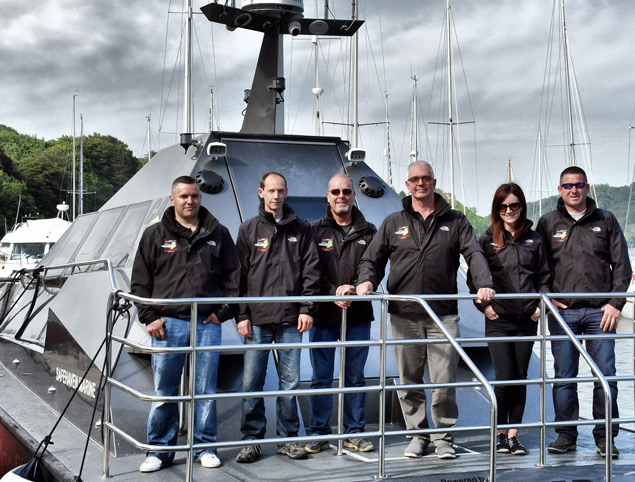 The Thunderchild crew on the current Round Rockall & Ireland Challenge are (left to right) Peter Gurgul, Ian Brownlee, Ciaran Monks, Frank Kowalski, Mary Power and Carl Randalls
The Thunderchild crew on the current Round Rockall & Ireland Challenge are (left to right) Peter Gurgul, Ian Brownlee, Ciaran Monks, Frank Kowalski, Mary Power and Carl Randalls
Safehaven Marine 'Thunder Child' Round Ireland & Rockall Speed Record Attempt Underway
Safehaven Marine began a speed record attempt around Ireland and Rockall this morning, starting from the Old Head of Kinsale writes Tom MacSweeney. The Cork company designs and builds naval and military craft, pilot and patrol boats and has been at the leading edge of speed boat design.
![]() FRank Kowalski and crew started at the Old Head of Kinsale and are heading anti–clockwise
FRank Kowalski and crew started at the Old Head of Kinsale and are heading anti–clockwise
Frank Kowalski is the Managing Director of the Company and said it looked like there was a "weather window to make our World record attempt in Thunder Child... It’s a bit marginal, but probably the best we can expect considering the current weather patterns forecast for the coming month, with continuous frontal systems moving across the North Atlantic into Ireland. Worst part looks like the West coast of Ireland with a significant wave height of 1.3m and a max of 2.2m with Force 3-4 winds Tuesday, but decreasing.
We decided to go anti-clockwise to give the swell there time to die down. Rockall is predicted at only 1m significant and 1.5m max, about as low as one could expect for North Atlantic, with light Force 2 winds. We will have a bit of weather heading off at the start Eastwards, but it’s a following sea along the South coast so we should be able to still make good speed, and then up the East coast it should be pretty calm. There is a new frontal system approaching Rockall on Wednesday with more strong winds, but we expect to be around Rockall and running ahead of that before it hits."


























